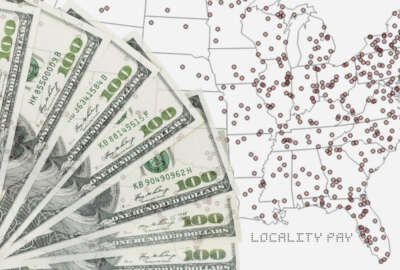Explainer
Dispelling some confusion around the new locality pay areas
In its final regulations, OPM said some commenters held “a mistaken belief” that certain counties were being inadvertently being excluded from the locality pay...
Ahead of the planned federal pay raise for 2024, more than 33,000 federal employees are now set to get even larger pay checks.
By the end of December, President Joe Biden plans to sign off on a 5.2% average pay raise for most federal employees on the General Schedule. The pay bump comprises a 4.7% across-the-board raise that everyone gets, plus a 0.5% average locality-based boost.
The pay raise — still pending final sign-off — will kick in starting in January. Military members are also expected to receive a 5.2% pay raise next year.
But in addition to the planned increase, the map that determines the average 0.5% of the raise that accounts for federal employees’ locations is changing next year.
Last month, the Office of Personnel Management finalized four new locality pay areas:
- Fresno-Madera-Hanford, California
- Reno-Fernley, Nevada
- Rochester-Batavia-Seneca Falls, New York
- Spokane-Spokane Valley-Coeur d’Alene, Washington-Idaho
Starting in 2024 and for each subsequent year, GS employees working in any of those four areas will receive a larger-than-before percentage for their locality-based raise.
The change will impact roughly 33,300 GS employees, a Nov. 16 final rule from OPM said. That accounts for a combined total of 17,100 GS employees being added to existing localities and another 16,200 GS employees in the new localities.
The final rule from OPM came after the President’s Pay Agent approved the four new locality pay areas last December, upon the recommendation of the Federal Salary Council earlier in 2022.
Previously, these feds were part of the “rest of U.S.” locality pay area, the catch-all group for any employees outside the other distinct pay localities. The rest of U.S. category is typically on the lower end of the locality-based raise amounts.
OPM occasionally implements new locality pay areas when it’s determined that the pay disparities significantly exceed those for the rest of U.S. locality pay area over an extended period of time.
Although the vast majority of the 405 commenters on the proposed regulations supported the changes, there was some misunderstanding and confusion about the details.
Specifically, OPM said some commenters held “a mistaken belief” that certain counties were being inadvertently excluded from the locality pay areas.
The confusion likely stemmed from disparity between the language of the proposed regulations and the final rule. Some counties that were written out in the proposed regulations were then left off of the final regulations.
For instance, in the Spokane-Spokane Valley-Coeur d’Alene locality pay area, Kootenai and Stevens counties were written in the proposed regulations, but were not listed in OPM’s final regulations.
But OPM clarified that these counties, as well as other counties in the four new localities that weren’t expressly stated, will still be included in the final list. OPM noted that it didn’t list out every single county in the regulations because they are implicitly included as part of the definitions of the four new areas.
The mapping of locality pay areas has changed relatively recently. Locality pay areas are measured by definitions from the Office of Management and Budget called metropolitan statistical areas (MSAs) and combined statistical areas (CSAs). MSAs, according to OMB’s definition, have at least one urban area with a population of 50,000 or more and include adjacent areas. CSAs are larger regions that can be a combination of multiple MSAs.
OMB’s MSA and CSA maps often change, but last year, the President’s Pay Agent determined that counties currently included in a locality pay area will remain on that locality — even if OMB removes them from an MSA or CSA in the future.
Aside from the new locality pay areas, OPM’s Nov. 16 regulations also added Clallam and Jefferson counties to the Seattle-Tacoma, Washington locality pay area.
OPM said it plans to soon post the definitions of the new locality pay areas — down to the county level — on its website.
The changes will then take effect for employees in the first full pay period after Jan. 1, 2024.
Copyright © 2024 Federal News Network. All rights reserved. This website is not intended for users located within the European Economic Area.
Drew Friedman is a workforce, pay and benefits reporter for Federal News Network.
Follow @dfriedmanWFED






